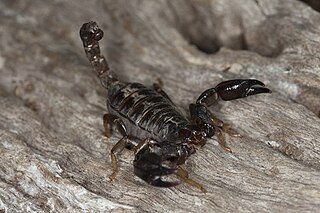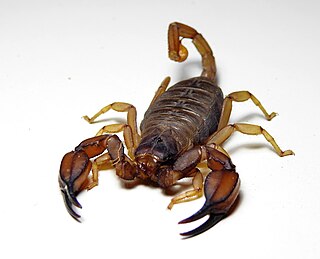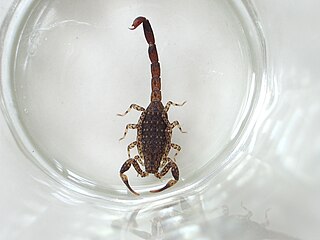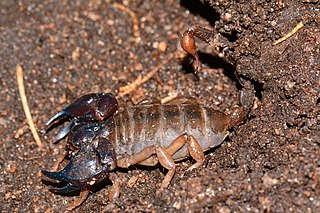
Thelyphonida is an arachnid order comprising invertebrates commonly known as whip scorpions or vinegaroons. They are often called uropygids in the scientific community based on an alternative name for the order, Uropygi. The name "whip scorpion" refers to their resemblance to true scorpions and possession of a whiplike tail, and "vinegaroon" refers to their ability when attacked to discharge an offensive, vinegar-smelling liquid, which contains acetic acid.
The taxonomy of scorpions deals with the classification of this predatory arthropod into 13 extant families and about 1,400 described species and subspecies. In addition, 111 described taxa of extinct scorpions are known.

Chaerilus is a genus of scorpions in the family Chaerilidae. They live in tropical parts of South Asia and Southeast Asia. A fossil genus Electrochaerilus is known from the Late Cretaceous (Cenomanian) aged Burmese amber.

The Scorpionidae make up the superfamily Scorpionoidea. The family was established by Pierre André Latreille, 1802.

Urodacus is a genus of scorpion belonging to the family Urodacidae. It was described by German naturalist Wilhelm Peters in 1861. The type species is U. novaehollandiae. Its species are native to Australia, and dig burrows. The genus was placed in its own family in 2000. Before this, the group had been a subfamily Urodacinae within the family Scorpionidae.

Urodacus manicatus, commonly known as the black rock scorpion, is a species of scorpion belonging to the family Urodacidae. It is native to eastern Australia.

Urodacus yaschenkoi, also known as the inland scorpion or the desert scorpion, is a species of scorpion belonging to the family Urodacidae. It is native to central Australia. It is also referred as the desert robust scorpion, because of its robust black colour and a long tail lined with a deadly hook.

Cheloctonus jonesii is a species of scorpion in the family Hormuridae native to southern Africa.

Urodacidae is a family containing two genera of scorpions, both of which are endemic to Australia. It was first described by British zoologist Reginald Innes Pocock in 1893. Formerly a subfamily (Urodacinae) of the Scorpionidae, it was later raised to family rank. Its sister taxon is the monotypic family Heteroscorpionidae, the species of which are confined to Madagascar.

Lychas is a genus of scorpions belonging to the family Buthidae. It is one of the most widespread genus of the scorpions, where the species are found throughout in Africa and Seychelles, and in the Oriental region from India to Melanesia.
Isometroides vescus, also known as the spider-hunting scorpion or spiral burrow scorpion, is a species of scorpion in the Buthidae family. It is native to Australia, and was first described by German arachnologist Ferdinand Karsch in 1880.
Lychas buchari, also known as the yellow sand scorpion, is a species of small scorpion in the Buthidae family. It is native to Australia, and was first described in 1997 by Czech arachnologist Frantisek Kovarik.
Urodacus armatus, also known as the yellow sand scorpion or inland desert scorpion, is a species of scorpion in the Urodacidae family. It is native to Australia. It was first described in 1888 by British zoologist Reginald Innes Pocock.
Urodacus centralis is a species of scorpion in the Urodacidae family. It has a limited range in central Australia, and was first described in 1977.
Urodacus butleri is a species of scorpion in the Urodacidae family. It is endemic to Australia, and was first described in 2012.
Urodacus excellens is a species of scorpion in the Urodacidae family. It is endemic to Australia, and was first described in 1888 by British zoologist Reginald Innes Pocock.
Urodacus hoplurus is a species of scorpion in the Urodacidae family. It is endemic to Australia, and was first described in 1898 by British zoologist Reginald Innes Pocock.
Urodacus macrurus is a species of scorpion in the Urodacidae family. It is endemic to Australia, and was first described in 1899 by British zoologist Reginald Innes Pocock.

Urodacus planimanus is a species of scorpion in the Urodacidae family. It is endemic to Australia, and was first described in 1893 by British zoologist Reginald Innes Pocock.









